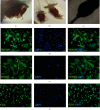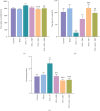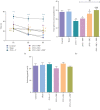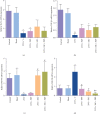Combination Therapy with Platelet-Rich Plasma and Epidermal Neural Crest Stem Cells Increases Treatment Efficacy in Vascular Dementia
- PMID: 38146481
- PMCID: PMC10749736
- DOI: 10.1155/2023/3784843
Combination Therapy with Platelet-Rich Plasma and Epidermal Neural Crest Stem Cells Increases Treatment Efficacy in Vascular Dementia
Abstract
This study aimed to evaluate the efficacy and treatment mechanism of platelet-rich plasma (PRP) and neural crest-derived epidermal stem cells (ESCs) in their administration alone and combination in vascular dementia (VaD) model by two-vessel occlusion (2VO). Methods. Sixty-six rats were divided into six groups: the control, sham, 2VO + vehicle, 2VO + PRP, 2VO + ESC, and 2VO + ESC + PRP. The treated groups received 1 million cells on days 4, 14, and 21 with or without 500 µl PRP (twice a week) after 2VO. The memory performance and anxiety were evaluated by behavioral tests including open field, passive avoidance, and Morris water maze. The basal-synaptic transmission (BST) and long-term potentiation (LTP) were assessed through field-potential recordings of the CA1. The mRNA expression levels of IGF-1, TGF-β1, PSD-95, and GSk-3β were measured in the rat hippocampus by quantitative reverse transcription polymerase chain reaction. Results. The results demonstrated impaired learning, memory, and synaptic plasticity in the 2VO rats, along with a significant decrease in the expression of IGF-1, TGF-β1, PSD-95, and upregulation of GSK-3β. Treatment with ESC alone and ESC + PRP showed similar improvements in spatial memory and LTP induction, with associated upregulation of PSD-95 and downregulation of GSK-3β. However, only the ESC + PRP group showed recovery in BST. Furthermore, combination therapy was more effective than PRP monotherapy for LTP and memory. Conclusions. The transplantation of ESC showed better effects than PRP alone, and combination therapy increased the treatment efficacy with the recovery of BST. This finding may be a clue for the combination therapy of ESC and PRP for VaD.
Copyright © 2023 Somayeh Akbari et al.
Conflict of interest statement
The authors declare that they have no conflicts of interest.
Figures









Similar articles
-
Time-dependent effects of platelet-rich plasma on the memory and hippocampal synaptic plasticity impairment in vascular dementia induced by chronic cerebral hypoperfusion.Brain Res Bull. 2020 Nov;164:299-306. doi: 10.1016/j.brainresbull.2020.08.033. Epub 2020 Sep 8. Brain Res Bull. 2020. PMID: 32916222
-
Gens PSD-95 and GSK-3β expression improved by hair follicular stem cells-conditioned medium enhances synaptic transmission and cognitive abilities in the rat model of vascular dementia.Brain Behav. 2024 Jan;14(1):e3351. doi: 10.1002/brb3.3351. Brain Behav. 2024. PMID: 38376050 Free PMC article.
-
The neuroprotective properties and therapeutic potential of epidermal neural crest stem cells transplantation in a rat model of vascular dementia.Brain Res. 2022 Feb 1;1776:147750. doi: 10.1016/j.brainres.2021.147750. Epub 2021 Dec 9. Brain Res. 2022. PMID: 34896332
-
Treatment with edaravone improves the structure and functional changes in the hippocampus after chronic cerebral hypoperfusion in rat.Brain Res Bull. 2021 Sep;174:122-130. doi: 10.1016/j.brainresbull.2021.06.006. Epub 2021 Jun 9. Brain Res Bull. 2021. PMID: 34116172
-
[Availability of 2VO rats as a model for chronic cerebrovascular disease].Nihon Yakurigaku Zasshi. 1999 Feb;113(2):85-95. doi: 10.1254/fpj.113.85. Nihon Yakurigaku Zasshi. 1999. PMID: 10205783 Review. Japanese.
References
LinkOut - more resources
Full Text Sources
Research Materials
Miscellaneous

